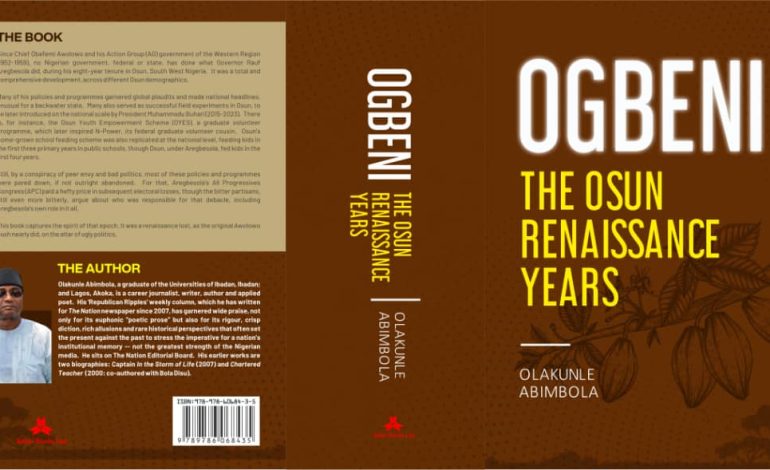Osun Dramatics

- By Kunle Abimbola
ABUSE of forum? Fulsome apologies! But be sure it’s both a logical and legitimate grist to tell the Osun tale: of development — or lack of it.
But first a blast into the past.
“Ogbe ‘A’ s’aya, Ogbe ‘B’ s’aya, Ogbe ‘D’ s’aya, Ogbe ‘E’ s’aya!…”
That was how we, kids in the Lafiaji area of Lagos Island, hollered and learned, by rote, the Yoruba alphabets — shouting at vivid pictures of humans bearing these alphabets on their chest, and bawling louder than the child next to you, to impress the teacher!
The school, St. David’s School, Okesuna, Lafiaji, Lagos, still stands till this day. The school, in concert with the many neighbourhood lessons, with teachers and their scary canes, drilled the first bit of formal learning, into the minds of the bawling kids.
You needed the Yoruba alphabet drills to start the all-Yoruba preparatory classes 1 and 2. The English alphabets waited till you made Standard 1, in those days when Lagos, as Federal Capital Territory, did eight years of primary school, before it was later pared down to six; and the class nomenclature changed from Standard to Primary.
That screaming kid of yore — among many others — is now the Ripples of today who, many confess, has a rather good grasp of English style, lexis and structure. Yet, the beginning was so humble!
Of course, the first eight — later six — years of formal schooling was free, thanks to the iconic Chief Obafemi Awolowo. Education couldn’t have been free in the West, while kids in its Yoruba outpost of Lagos (though then federal capital) would pay?
Much later, the federal authorities — under Gen. Yakubu Gowon and Lagos State Military Governor, Col. (later Brigadier) Mobolaji Johnson — would add a boon: heavily subsidized high-quality mid-day meals, that saved the kids, mainly from poor homes, from the vendor shylocks, that dished low-quality food at outrageous prices!
Boy! Didn’t many of us taste those exotic meals, complete with fruits and chilled milk, for the first time in school — even taking home little rations for our younger siblings?
Why this flashback, though? Simple: The motivation to write Ogbeni: The Osun Renaissance Years, stemmed from sharing childhood kin with thousands of Osun kids, from humble homes, basking in the warmth of their government’s policy sun.
Safari Books, Ltd, Ibadan, released the work in May.
READ: The Discourse: “Hafsa: Salary Crisis”
Ogbeni is an ode to a government that placed the poor as the central plank of its policies — and politics.
But in Rauf Aregbesola’s Osun, it wasn’t school feeding alone, in the first four years of schooling. It was the total transformation of the school and study environment.
Why, a visit to the sedate classrooms, at Osogbo’s Anthony Udofia Elementary School, felt like becoming a child again, and being taught in such comely classes, with their sweet libraries; and for mid-day sports, romping into the enchanting play grounds!
Whither those glittering facilities today, less than eight years later, though the school still stands? The answer is up in the wind! That appears the retrogressive streak of Osun politics and dramatics! The poor, more than anyone, are the ultimate victims.
But the enchanting windows of Udofia — and the contiguous Government High School, Oke-Fia (now Osogbo Grammar School): the Osun model mega high school that in 2020 produced Abdullahi Akintade as Nigeria’s best student scientist, barely four years after the new school opened in 2016 — were a loud metaphor for youth education, training and empowerment.
The youngest were fed — and the feeding itself was structured to put money in the pockets of these children’s farmer and caterer-parents. The kids were also put in transformed schools, from the hitherto shambolic, nay collapsed, public school system, in the most radical transformative intervention in Osun history.
The most senior — the senior secondary (SS) 3 classes — were equipped with “Opon Imo”, units of computer tablets that were warehoused, quoting from Ogbeni, “54 e-textbooks covering 17 subjects, 54 (video) tutorials covering 17 subjects, over 40, 000 practice questions-and-answers, and seven extra-curricular books”, which included the Bible, the Qur’an, and the Ifa Corpus, covering the varying faiths.
Even the common uniform project — as controversial as that was — was wrought to standardize tailoring and design skills, to feed orders to thousands of Osun artisan tailors, via the intervention of the Omoluabi Garment Company, now defunct.
Again, where is Opon Imo today? Indeed, where’s that Garment company, which the Aregbesola order then promoted as the biggest garment business in West Africa?
Gone with the wind! For context, Kwara, under Governor AbdulRahman AbdulRasaq, has appropriated a similar idea; and is running with own factory, with the promise of jobs for its youth and tax for its purse.
For youth jobs: the same government framed OYES: the Osun Youth Empowerment Scheme. OYES volunteers not only out-numbered the Osun Civil Service, OYES also triggered N-Power, the graduate scheme, after its image, on the national front, under President Muhammadu Buhari — just as Osun’s school feeding inspired a national home-grown school-feeding programme, as a safety net for the poor.
More critically, OYES triggered the World Bank version of YESSO: the Youth Employment and Social Support Operation. YESSO gathered data to compile a National Social Register (NSR) for conditional cash transfers to the very poor, complete with opportunities to train in skills to make ends meet. The NSR came handy during the terrible months of COVID-19.
Yet, where is OYES today?
Osun 2010-2018 was total human development: from youth to the seniors’ welfare and empowerment dubbed “Agba Osun”, and public health, using aggressive road and sundry infrastructure as a spur, but making the common man the crux of policy.
Indeed, since the Awolowo Western Region government (1952-1959) — which by the way had bouncing cocoa wealth — no sub-national government in Nigeria has essayed audacious development as Osun did, under Aregbesola, though with puny resources.
Ogbeni: The Osun Renaissance Years, soon to be publicly presented, captures these momentous strides, with its many crises and controversies.
All through that epoch, the media slept and snored, though a good section of it would jerk awake to dish out explosive ignorance from arch-bias — wanton abuse that gave the Fourth Estate a bad name.
Ogbeni pushes a more balanced account for posterity, say, some 100 years from now. But before then, what if it gets to 100, 000 young African leaders as a primer for how to put the poor at the core of government policies? Exciting?
Culled from The Nation of July 2nd, 2024
The opinions expressed in this publication are those of the author. They do not represent the opinions or views of OSUN DEFENDER.









